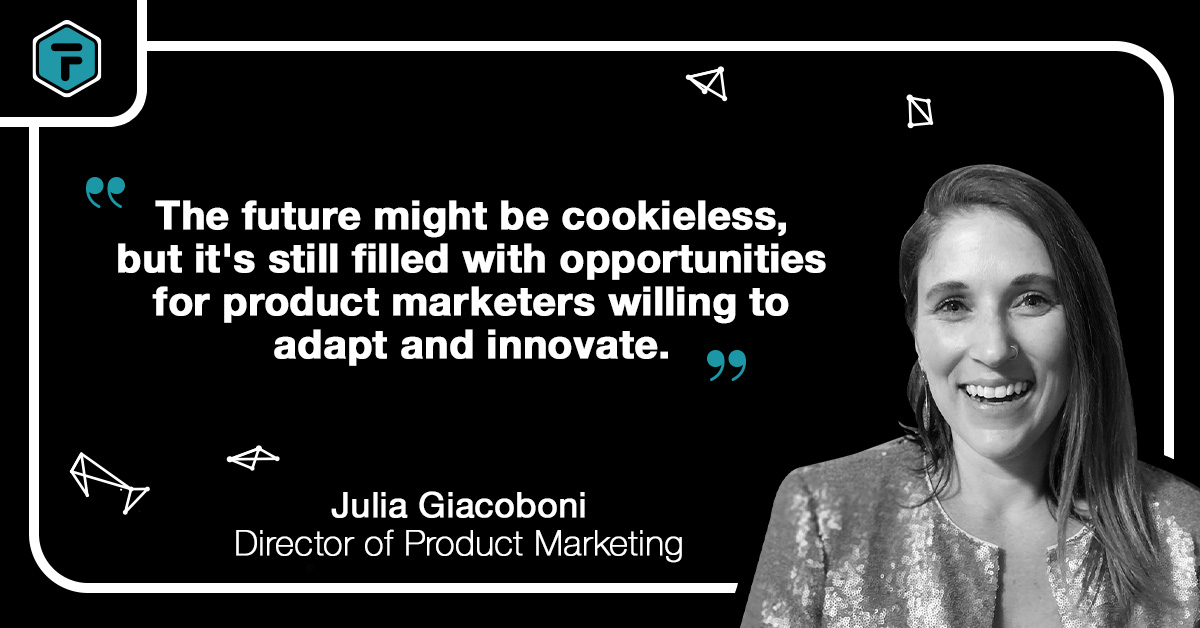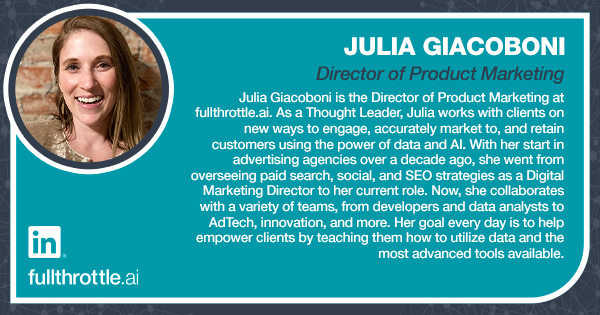
By: Julia Giacoboni, Director of Product Marketing
Bold Approaches for a Cookieless Future
You know the drill. But I'll say it for old times' sake — cookies are going away. As the digital advertising landscape continues to evolve, marketers are faced with a new challenge: the decline of third-party cookies. In response to increased privacy concerns and pending stricter legislation, major web browsers like Google Chrome have preemptively started to phase out support for third-party cookies. As tracking users across different websites has become increasingly difficult and will continue to be so, marketers need to use cookieless product marketing to reach their target audience.
Top takeaways:
- Embrace the cookieless future with enthusiasm and innovation, as it presents new opportunities for product marketers to explore and adapt their strategies.
- Shift focus to building a robust first-party data strategy, which will allow you to gain a deeper understanding of your customers and tailor your messaging accordingly.
- Reignite your passion for content marketing by creating engaging, dynamic, and high-quality content that builds relationships with customers and drives conversions.
- Leverage the power of social media platforms, influencer collaborations, and industry experts to extend your reach, build credibility, and tap into engaged audiences.
The fact that cookies are being deprecated sometime soon probably isn’t new to you. What’s it now? End of 2024? Got it.
But here’s a kicker: it doesn’t just affect websites and digital marketers. It affects product marketers like me, too!
Why does it affect me as a product marketer? As a product marketer, part of my job focuses on understanding our customers and end users — communicating to them accurately, targeting them effectively, and supporting their use and adoption of our products.
Cookies have traditionally played a big role in the product marketing process. They allow marketers to easily track user behavior and tailor messaging based on interests and preferences, so it’s sad to see them go — but hey, it’s cool, ‘cause I’m someone who practices what I preach! So, let me walk you through how you can market your products without third-party cookies.
Build a First-Party Data Strategy
With third-party cookies on the decline, first-party data has become the gold standard. This is not a surprise! We've been shouting it from the rooftops for … years?
First-party data is information collected directly from your customers, such as addresses or purchase history. By building a first-party data strategy, product marketers can gain a better understanding of their customers and tailor their messaging accordingly. This tactic is key to building a list of people who will want to buy what you’re selling. Plus, it allows you to show up on any DSP or ad platform with a list in hand, so you're ready to go! (Remember: the money is all in the list.)
Owning your customer data without relying on walled gardens, like Facebook and Google, allows you to take that data anywhere you want. If you decide to take your toys and go home, you won’t be tied down and locked in by the big dogs. That freedom may come in handy!
The fullthrottle.ai® platform makes this a breeze, by the way. Once it’s installed, you’ll start building your own list from anonymous site traffic that turns engaged visitors into addressable households.
Emphasize Content Marketing
In a world without cookies, content can step back up as king. It's not just about crafting fancy stuff; it's about serving up real value to your audience. Think blogs, case studies, eBooks, podcasts — your content should be the go-to resource for your customers. And hey, don't sleep on lead magnets. Offering something compelling, like a free trial or discount code, is a great way to reel them in.
As usual, there’s a catch: cookieless product marketing isn't just a fire-and-forget rocket. You have to keep it fresh and exciting. Stay tuned to trends, mix things up with different formats, and don't be afraid to color outside the lines. Plus, your brand's voice? Super important. Keep it real and consistent. In this cookieless landscape, your content is the warm, inviting porch light that leads customers to your brand. So, let's get down to business and create content that keeps 'em coming back!
Build a Network
All right, I know the word “network” just made some of you gag, but it’s important! In a cookieless world, it's absolutely crucial to buddy up with your partners, clients, and colleagues. After all, friends who market together, succeed together. These connections can lead to some seriously valuable referrals, collaborations, and co-marketing opportunities that'll make your message be heard loud and clear.
So, what are you waiting for? Dive into networking events, online forums, and industry conferences like a social butterfly. Make sure you're joining conversations that matter to your target audience — it's not only going to help build your personal brand, but it'll also make you the go-to person in your field. Trust us, cultivating these relationships will create a community that backs your cookieless product marketing efforts and helps you soar. Go on and spread those wings!
Leverage Social Media Platforms
As users continue to spend more time on social media, it's essential to capitalize on the power of these platforms for product marketing. Through organic and paid social media campaigns, you can target audiences based on their interests, behaviors, and demographics. By creating engaging content and fostering conversations, you can build brand loyalty and drive conversions. We could write a whole post on this, so I’ll keep it at that for now!
Collaborate With Influencers and Industry Experts
Here's a tip — don't underestimate the power of influencers and industry experts. These folks have worked hard to build a loyal following that trusts their advice and recommendations. By collaborating with the right people, you're not just extending your reach — you're also adding a touch of authenticity and credibility to your brand.
But remember, not all influencers are created equal. You'll want to partner with folks who align with your brand values and resonate with your target audience. Take the time to research and find the right fit. When done right, these collaborations can work wonders, leading to increased brand visibility, engagement, and even conversions. So, start building those relationships and tap into the magic of influencer marketing in this cookieless era.
Get the Right Tools for the Job
Utilizing cookieless product marketing means you have to adopt new strategies and tactics. By focusing on first-party data, content marketing, contextual targeting, building networks, leveraging social media platforms, and collaborating with influencers, you can reach your target audience and craft the messages they respond to. The future might be cookieless, but it's still filled with opportunities for product marketers willing to adapt and innovate.
At fullthrottle.ai®, we’ve had our eyes on the cookieless horizon for years. The patented technology powering our platform gives product marketers an unprecedented look at who’s interested and where they fall in the buyer journey, without a single cookie used. We establish a clear view of your shoppers and any associated attribution — with sales tied directly to business transactions for a complete customer journey ROI. Book a demo with us and take a look for yourself.




